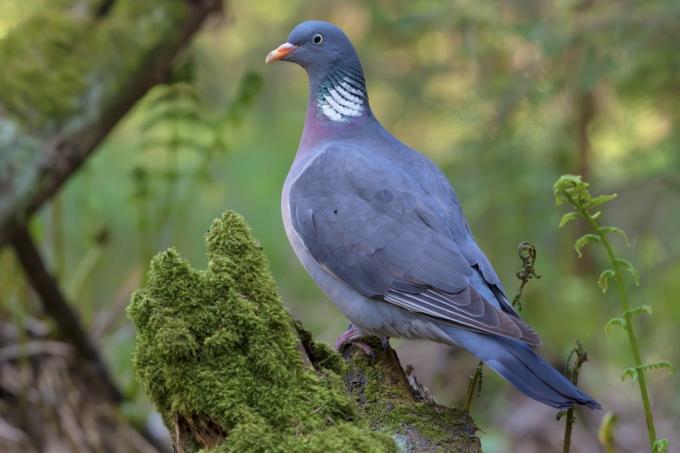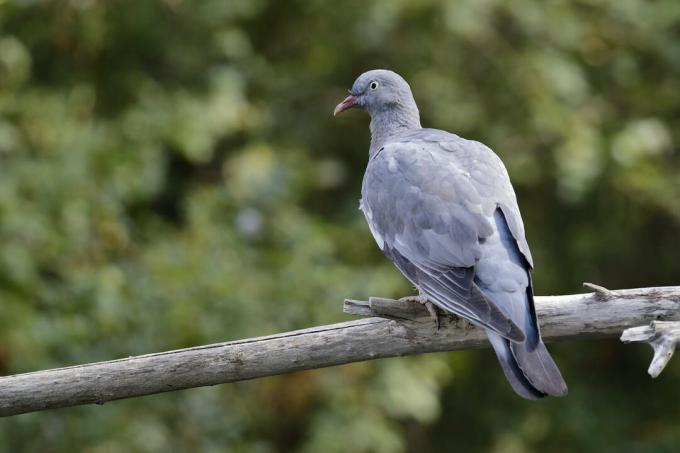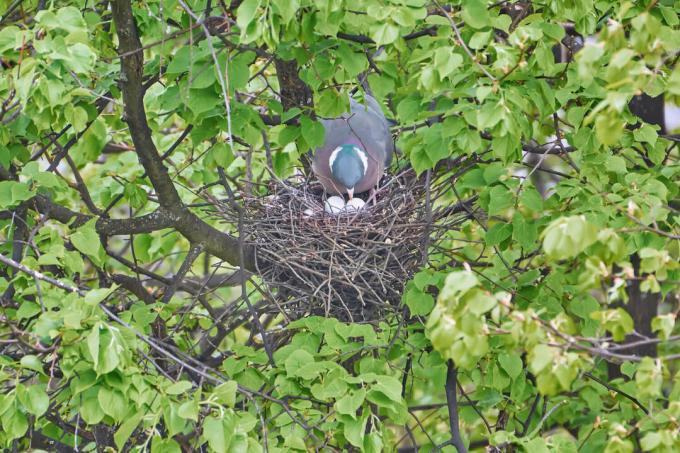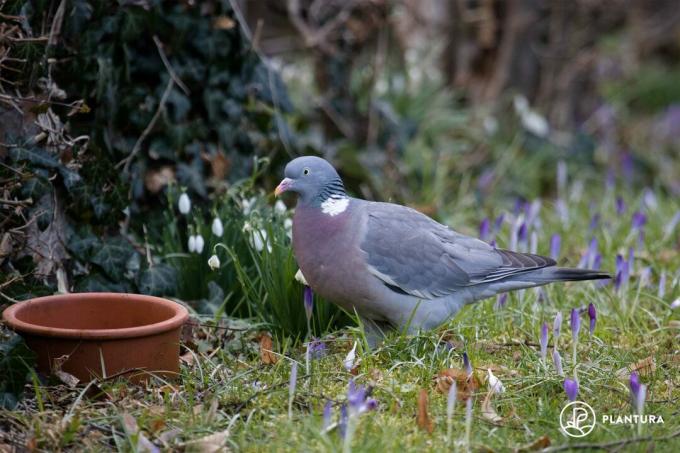Would you like to know what wood pigeon eggs look like, where the bird builds its nest and how you can recognize young wood pigeons? You can find out this and more in our profile.

The wood pigeon (Columba palumbus) is also called forest pigeon by us, to distinguish it from the common street pigeon. Wood pigeons are very widespread and frequent breeding birds across Europe. Well recognizable by the white elements on the neck and wings, the pigeon birds can be observed in forests as well as in settlements and large cities. A special spectacle is offered during the breeding season, when the male clapping wings from the treetops and then gliding at the females presents. How you can also recognize the singing of the wood pigeon without a doubt, what their young look like and much more, you can find out here in our large profile.
contents
- Wood pigeon: profile
-
This is how you recognize the wood pigeon
- How does the wood pigeon singing sound?
- How do you recognize a young wood pigeon?
- What do wood pigeon eggs look like?
- Which habitat does the wood pigeon prefer?
- Where does the wood pigeon build its nest?
- When is the breeding season of the wood pigeon?
- Where does the wood pigeon spend the winter?
-
Support the wood pigeon in the garden: This is how it works
- What do wood pigeons eat?
- Which nesting aids are suitable for wood pigeons?
- How can you additionally support the wood pigeon?
Wood pigeon: profile
| size | Approximately 38 - 45 cm |
| weight | Up to 600 g |
| Breeding season | February - November |
| lifespan | About 15 years |
| habitat | Forests, parks and gardens |
| Feed preference | Seeds, nuts, buds and berries |
| Threats | Decline in food and living space |
This is how you recognize the wood pigeon
Wood pigeons are very easy to identify. The birds' heads, backs and elytra are uniformly blue-gray. Her chest is characterized by a delicate pink and the belly is a light beige brown. When seated, the clearest identification mark of the pigeon birds is a large white patch on the neck, which can also be seen well from a distance.

In flight, broad white stripes also appear on the wings of the wood pigeons, which serve as a further distinguishing feature. Male and female wood pigeons can unfortunately not be distinguished from a purely optical point of view.

How does the wood pigeon singing sound?
The singing of wood pigeons is one of the most memorable bird calls ever. With a muffled, rhythmic cooing, they sing a five-syllable stanza that can still be heard from a great distance: "Dhu-dhu-dhu... dhu-dhu".
Here you can listen to the wood pigeon singing:
Note: One can only confuse the singing of the wood pigeon with that of the Turkish dove. This native pigeon species, which is also common, has a similar cooing song, but only consists of three instead of five syllables.
How do you recognize a young wood pigeon?
As soon as young wood pigeons have left the nest and are completely feathered, they already look very much like their parents. The gray-blue color and the characteristic white wing bands clearly distinguish them as wood pigeons. What is still missing, however, is the white spot on the neck, which only appears a few weeks later.

What do wood pigeon eggs look like?
Wood pigeons lay monochrome white eggs about 4 centimeters in size. The clutches almost always consist of two eggs, which are laid in a nest made of loose twigs. In rare cases, even a single egg is laid.

Which habitat does the wood pigeon prefer?
Wood pigeons are extremely widespread and basically settle wherever there are trees. The potential habitats include dense forests as well as parks and gardens as well as individual groups of trees in the landscape, cemeteries or avenues.
Where does the wood pigeon build its nest?
The wood pigeon builds their nest in trees, hedges and other vegetation. In cities, building projections are also used as nesting places. Both breeding partners take part in the nest building itself, with the male mainly bringing in nesting material and the female weaving the fine twigs into a nest. However, the nests are not built with particular care - they are often so thin that you can see the eggs from below.

When is the breeding season of the wood pigeon?
Wood pigeons have an unusually long breeding season. This extends from February to November and can contain up to four broods. The individual clutches are incubated for around 16 days before the young birds hatch. The young are then fed in the nest for about four weeks until they are fully developed. After that, they are very soon left to their own devices because their parents are already devoting themselves to the next brood.
Where does the wood pigeon spend the winter?
Our native wood pigeons also spend the winter in their breeding areas and can therefore be observed with us all year round. During this time they often form larger swarms and move through the wintry landscape together. However, their conspecifics from Northern Europe escape their homeland in the cold season and move to the south.

Support the wood pigeon in the garden: This is how it works
The wood pigeon is also a frequent guest in home gardens, perches on trees and even comes to feeding places in winter. Find out here how you can prepare your garden for the feathered visitors.
What do wood pigeons eat?
Wood pigeons are almost exclusively vegetarian and search for food on the ground and on trees or in bushes. They use leaf and flower buds, berries, acorns, beechnuts and grain seeds. Occasionally, however, they also consume animal food - in the form of insects, snails or worms. The wood pigeons also feed their young with a protein and fat-rich crop milk that the parents of the birds make themselves.
Wood pigeons can also be seen at feeding stations, especially in winter. There they make use of grain or litter. You can therefore also offer the garden birds our Plantura litter for wild birds, which contains lots of high-quality ingredients that provide energy for the cold winter months. Simply bring the food to a dry place in the garden or on the balcony and support wood pigeons and numerous other wild birds.
Which nesting aids are suitable for wood pigeons?
Wood pigeons are free breeders and therefore cannot be impressed with classic nesting boxes. Suitable nesting sites in gardens, on the other hand, are tall trees or hedges, which should not be thinned out too much in order to provide cover. And if you do have a brush pile left over from the last hedge cut, you can leave it in the garden let - this is how you offer nesting material for wood pigeons and at the same time give one to many other garden visitors Habitat.
How can you additionally support the wood pigeon?
They need a lot of drinking water to produce the crop milk that the wood pigeons feed their young. With a water point in the garden you can support the pigeon birds. A pond, a stream or even a simple bird bath are popular with visitors. However, always ensure that your water points are cleaned regularly, as otherwise diseases can spread.

Incidentally, the wood pigeon is not under special protection and may even be hunted here. For years, German nature conservation associations have been campaigning for the wood pigeon to be released from hunting law and included in nature conservation law.
The singing of the wood pigeon has a high recognition value and is therefore perfect for an introduction to learning bird calls. Other species with distinctive singing, which you can also get to know in our detailed species portraits, are, for example Chiffchaff, the blackbird or the Great tit.

